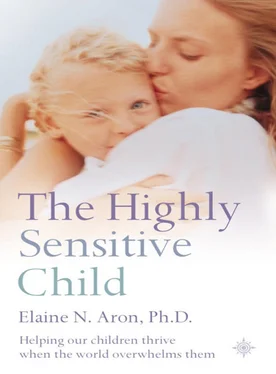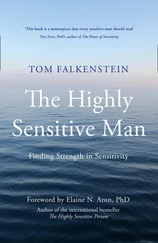WITH AN HSC, YOU MAKE A BIGGER DIFFERENCE
Every now and then someone is on the talk-show circuits arguing that genetics determine everything and parenting does not matter. Yes, at one time there was probably too much emphasis on the role of parenting, especially mothering, in shaping a child’s personality. No one even considered the role of inherited temperament. So a balance was certainly needed.
Ironically enough, however, the research is now clear that parenting does matter, and much more, in raising children like HSCs, whose temperaments are at the extreme end of normal. And in studies done with monkeys, “reactive” (sensitive) monkeys randomly assigned at birth to be raised by especially calm mothers (studies we cannot do with humans) turned out to be far more resilient adults, even troop leaders, compared to those raised by nervous mothers. Reactive monkeys who were randomly assigned to be subjected to separations from their mothers, on the other hand, were far more affected in adulthood by this trauma than less reactive monkeys.
Most HSCs do not have to deal with being totally separated from their caregiver, but research finds that they are more likely to be affected by caregivers who are mentally absent—due to stress or depression, perhaps—or who would just as soon not be there, or who may be overly afraid themselves about losing a close other. For example, Megan Gunnar and her colleagues at the University of Minnesota found that highly sensitive nine-month-olds left for a half hour with an attentive baby-sitter “playmate” were far less distressed physiologically during this separation from their mothers than they were when they were left with an inattentive caregiver. An attentive caregiver was almost as good as having mom present, but an inattentive one made the separation more stressful for HSCs than non-HSCs.
In another study, focusing on the general security or insecurity of the bond with the mother, these same researchers found that highly sensitive eighteen-month-olds who were generally insecure with their mothers (I will discuss this more in Chapter 6) had distressed bodily reactions in new situations, while secure HSCs were not affected. Non-HSCs were also not distressed by new situations, of course—whether their relationship with their mother was secure or not. That is, only the insecure HSCs’ were deeply distressed in new situations. Several more studies have found the same general results.
The conclusion? “A history of responsive, sensitive caregiving … provided the securely attached infant with the resources to reduce activation of the [bodily distress] system, even though the child’s temperament might bias him or her to experience novel events as ‘potentially’ threatening.” In other words, when sensitive toddlers are in the stressful situation of being separated from their mothers, they are all right if left with a caring person and not all right if left with an inattentive person. If they are in an unfamiliar situation that is particularly stressful for them, they are more affected by an insecure attachment to their mothers. They are very affected by the sense they will receive help if they need it. Not only do HSCs need to perceive support in such situations because they are more aware of the dangers, but they are also probably more aware of the degree of support and caring of their mothers and other caregivers.
GOODNESS OF FIT—EACH CHILD EXPERIENCES A DIFFERENT FAMILY, A DIFFERENT FIT
Interestingly, researchers find that whatever a family does do to influence a child’s personality, it affects each child differently, as if each is growing up in a completely different family. Some of this is due to the parents being in a different situation when each child is born, and some of it is that each child is different so parents respond differently, or conversely, the same parenting methods may affect two children quite differently, depending on their temperaments. Probably most parents are not “good” or “bad” so much as they are specialists, naturally working well with some temperaments more than others.
The implication is that if you have more than one child, one may thrive in your care, another may not do as well. But research also finds that a little understanding and training can affect that greatly—“goodness of fit” matters more than parent and child having the same temperament. A good fit is a family and school environment that supports and encourages a child’s natural way of behaving. In one family, a quiet artist who does not like sports will be considered ideal. In another, this child will be a huge disappointment. But there is always a good fit when parents accept their children for who they are , then adapt their methods to suit the child. Studies in which parents are trained to understand their child’s temperament consistently find that the children of these parents have far fewer problems.
One way to describe this book is to say it is essentially about what you can do to create a good fit between you and your child. Since each of you are individuals, this book will sometimes miss something important about one or both of you. That is why I am saying right here that it is smart to have a top-notch temperament counselor or therapist aware of temperament to whom you can turn while raising your HSC. That way you do not have to go looking for someone when you feel you’re in a crisis. You have a professional to help you with your taxes or when buying a house. Why not with parenting?
This book can, however, take you a long way with your HSC, because there is so much that HSCs have in common that most “child experts” do not know. We will begin with one of the big ones: To create a “good fit” you must learn to appreciate your child’s excruciating sensitivity to you , the One in Charge. Fortunately, although I did not know it, I had been forced to appreciate this reality even before I had my own HSC.
The Beagle and the Border Collie
As I said in Chapter 1, the fact that there are different breeds of dogs is a good way to understand that there can be different “breeds” of children, too. We know some dog breeds are well suited for some owners, but not for others—that’s why there are so many. But the owners can also learn to adapt to the temperaments of their dog. If they learn in time.
When I was young, my parents bought me a beagle I promptly named Star. If you know beagles, they are generally tough little dogs with a nose that takes them exploring everywhere, at which times they could care less about you or anything else but The Scent. I suppose they are sensitive in their noses, but nowhere else. When Star was about a year old, my mother and I became involved in obedience training and eventually she, then I, tried to show Star in dog shows. In the show ring she was an angel while on a leash, but once off it, she was out of there , running sometimes for blocks, following the aroma of her Holy Grail. Later we bought poodles to train and show—they were perfect for obedience shows, but they were high-strung performers, terribly nervous and demanding of attention.
After I left home and married, I wanted another dog and another breed. I did not know why (not knowing yet that I was highly sensitive or that dogs could vary on this trait), but I had always admired border collies—those black-and-white dogs that herd sheep. I was sure they would be perfect for showing in obedience-training shows. So I bought one, and soon had a devoted, intelligent companion.
This dog, Sam, seemed able to read my mind. Housebreaking was easy—I just took her outside while she was “making her first mistake,” and she never made another. She only tore up one object while teething—I was home later than usual one evening and I found bits of an old paperback for a psychophysiology course, appropriately titled Animal Emotions , all over the floor. Had she learned to read?
Читать дальше











